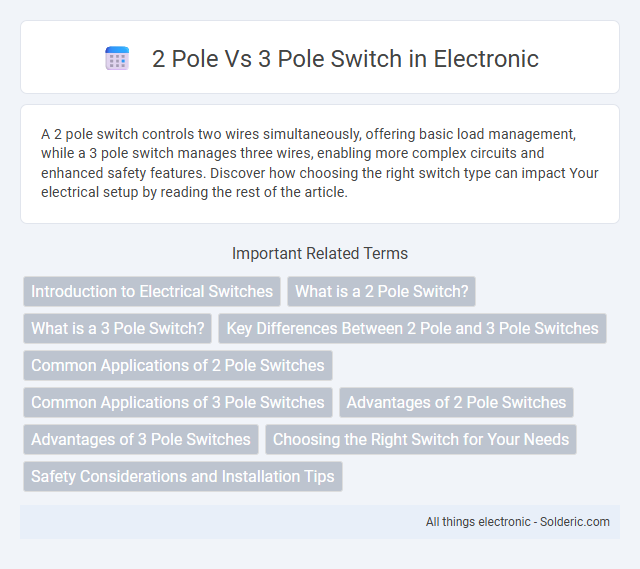A 2 pole switch controls two wires simultaneously, offering basic load management, while a 3 pole switch manages three wires, enabling more complex circuits and enhanced safety features. Discover how choosing the right switch type can impact Your electrical setup by reading the rest of the article.
Comparison Table
| Feature | 2 Pole Switch | 3 Pole Switch |
|---|---|---|
| Function | Switches two wires (usually live and neutral) | Switches three wires simultaneously, commonly used in three-phase systems |
| Application | Single-phase electrical circuits | Three-phase electrical circuits |
| Voltage Handling | Typically up to 240V | Typically up to 480V or higher in industrial use |
| Poles | 2 poles | 3 poles |
| Use Case | Residential wiring and appliances | Industrial motors, machinery, and large equipment |
| Cost | Lower cost due to simpler design | Higher cost because of complex setup and applications |
Introduction to Electrical Switches
Electrical switches control the flow of electricity by opening or closing circuits, with 2-pole and 3-pole switches serving distinct roles in power distribution. A 2-pole switch interrupts two wires simultaneously, typically used in double-phase systems, while a 3-pole switch manages three wires, suitable for three-phase power setups common in industrial applications. Your choice between these switches depends on the electrical system configuration and the load requirements.
What is a 2 Pole Switch?
A 2 pole switch controls two separate circuits simultaneously by switching both the live and neutral wires, providing enhanced safety and functionality in electrical systems. It is commonly used in appliances or equipment that require double-pole disconnection to ensure complete isolation from the power source. Understanding your needs for circuit control will help determine if a 2 pole switch is suitable for your application.
What is a 3 Pole Switch?
A 3 pole switch is an electrical device designed to simultaneously control three separate circuits or phases, typically used in three-phase power systems for industrial or commercial applications. It provides enhanced safety and operational efficiency by disconnecting multiple live wires at once, ensuring balanced load management and preventing electrical hazards. Compared to a 2 pole switch, the 3 pole switch is essential for managing complex electrical setups requiring three-phase power distribution.
Key Differences Between 2 Pole and 3 Pole Switches
A 2 pole switch controls two separate circuits simultaneously, typically handling 240V applications by interrupting both live wires, whereas a 3 pole switch manages three circuits, commonly used for three-phase electrical systems, allowing control of three live wires. The 2 pole switch is ideal for single-phase equipment, providing isolation of both conductors, while the 3 pole switch is essential for industrial and commercial three-phase motors and machinery requiring synchronized switching. Voltage ratings and current capacities vary, with 3 pole switches designed to handle higher power loads due to the additional phase control.
Common Applications of 2 Pole Switches
2 pole switches are commonly used in residential lighting and small appliance circuits, where controlling two wires simultaneously ensures safety and reliability. Your home lighting systems often rely on 2 pole switches to manage both live and neutral connections effectively, providing efficient circuit interruption. These switches are favored for their compact design and robust performance in controlling standard electrical loads.
Common Applications of 3 Pole Switches
3 pole switches are widely used in industrial and commercial settings to control three-phase electrical systems, ensuring balanced power distribution across multiple circuits. They are commonly found in motor starters, HVAC systems, and heavy machinery where simultaneous switching of three live wires is essential for safety and efficiency. Your choice of a 3 pole switch can enhance system reliability and simplify complex electrical installations.
Advantages of 2 Pole Switches
2 pole switches offer the advantage of controlling two separate circuits simultaneously, making them ideal for appliances requiring double-pole protection or dual power sources. They provide enhanced safety by disconnecting both live and neutral wires, reducing the risk of electric shock and equipment damage. Your electrical system benefits from their straightforward design, ensuring reliable performance and easier installation compared to more complex 3 pole switches.
Advantages of 3 Pole Switches
Three-pole switches provide enhanced control by simultaneously managing three circuits or phases, making them ideal for three-phase electrical systems. They ensure better safety and reliability through coordinated disconnection, reducing the risk of electrical faults. Their compact design also simplifies wiring and installation in complex industrial applications.
Choosing the Right Switch for Your Needs
Selecting the appropriate switch depends on the specific electrical requirements and application type. Two-pole switches are ideal for controlling both live and neutral wires simultaneously, providing increased safety in 240V circuits often found in residential settings. Three-pole switches are designed for three-phase power systems, commonly used in commercial and industrial environments to manage three separate live wires, ensuring balanced load control and enhanced performance.
Safety Considerations and Installation Tips
A 2 pole switch controls two separate circuits or phases simultaneously, ideal for 240V appliances, while a 3 pole switch manages three circuits, typically used in three-phase power systems for industrial safety. Ensuring proper grounding and correct wiring per electrical codes is crucial for both types to prevent electrical hazards and guarantee reliable operation. You should verify the load requirements and consult a certified electrician to ensure safe installation and compliance with local safety standards.
2 pole vs 3 pole switch Infographic

 solderic.com
solderic.com